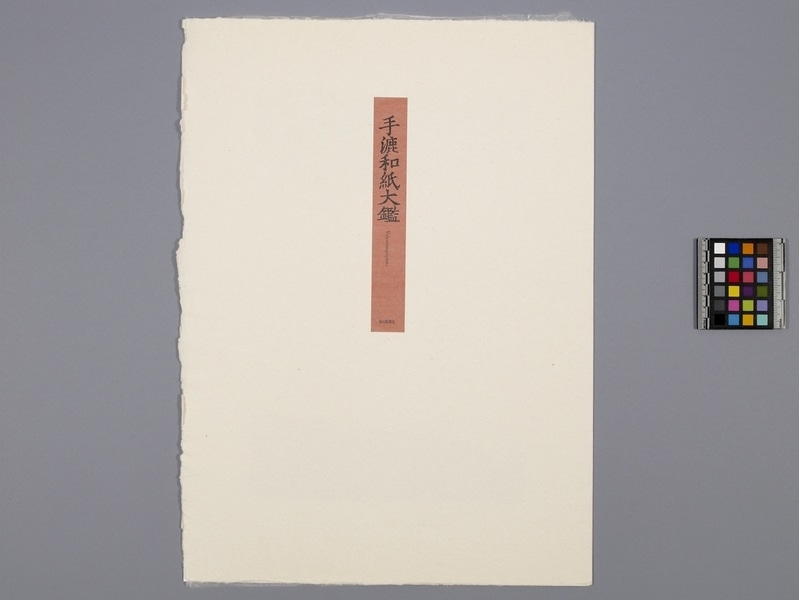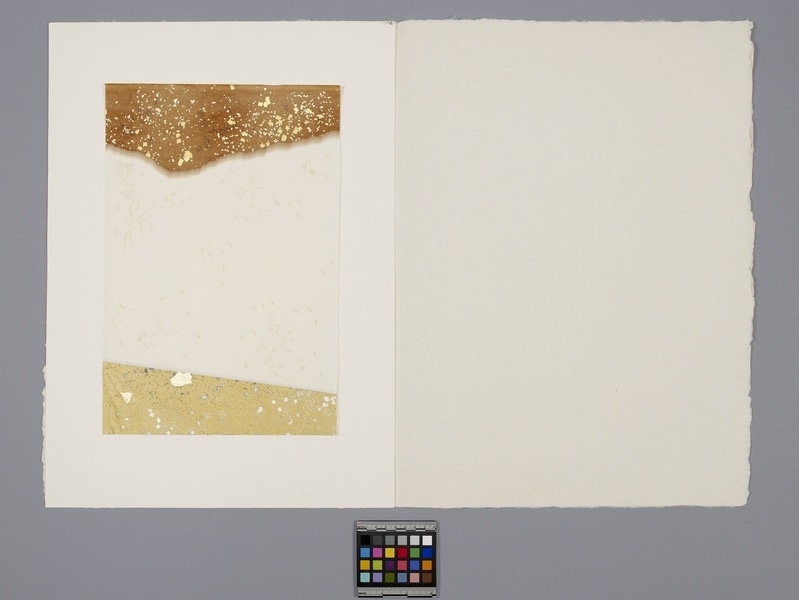Paper Item Number: Ed5.2122 a-b from the MOA: University of British Columbia


Description
Sample (a) has large white brown middle section with faint white brown, shining scene of reeds and boat(?), and fine gold-coloured grass and floral motifs scattered randomly overtop. Flanked on vertical by coloured sections joined to edges: on left, yellow brown with silver and some gold foil pieces; on right, brown with gold foil pieces and irregular inside edge from five overlapping sheets joined together. Sample pasted to thick white mount that has information printed on back. Sample protected by rectangular piece of white covering gauze and folder (b): thick, heavy, roughened, yellow white paper, folded over, flap opening from left, all edges retaining an irregular deckle edge. Brown rectangular strip on front has black printing of paper name in Japanese and English.
History Of Use
Papermaking originated on the Asian mainland and spread to Japan by 1500 years ago. For centuries Japan has produced the greatest quantity and variety of handmade paper or washi in the world. Traditionally, papermaking was a family or community enterprise which thrived in mountain farming communities where cold, pure water and wild bast fibre shrubs, such as mulberry, are plentiful. Washi is an important cultural symbol and holds a place in nearly every aspect of Japanese life. It is also a significant aspect of both Shinto and Buddhist rites and customs. Writing paper, made in imitation of paper on which is written a poem from 'Poems by 36 Poets' Anthology (Heian Period, 794-1191 C.E.) treasured by the Nishihonganji Temple, Kyoto.
Narrative
This is part of the Tesukiwashi Taikan, a collection of handmade paper published, in an edition of 1000 copies, in Tokyo as a project to commemorate the centennial of Mainchi Newspapers and to preserve Japanese handmade paper. A collection on this scale had not been made before. This collection consists of 5 boxes of mounted and labelled samples with an explanatory book in 4 of the boxes. The text is in Japanese and with less detail, in English. Compiled and edited by a special editorial staff of scholars. Published by the Mainchi Newspapers of Tokyo, Japan.
Cultural Context
sample
Item History
- Made by Keiu Kayasuga (Maker) in Okayama, Japan before 1974
- Collected during 1977
- Owned by Yoshihisa Okamatsu before March 23, 1977
- Received from Yoshihisa Okamatsu (Donor) on March 23, 1977
What
- Name
- Paper
- Identification Number
- Ed5.2122 a-b
- Type of Item
- paper
- Overall
- height 50.6 cm, width 37.3 cm
Who
- Culture
- Japanese
- Creator
- Keiu Kayasuga (Maker)
- Previous Owner
- Yoshihisa Okamatsu
- Received from
- Yoshihisa Okamatsu (Donor)
Where
- Holding Institution
- MOA: University of British Columbia
- Made in
- Okayama, Japan
When
- Creation Date
- before 1974
- Collection Date
- during 1977
- Ownership Date
- before March 23, 1977
- Acquisition Date
- on March 23, 1977
Other
- Item Classes
- works on paper
- Condition
- good
- Accession Number
- 0369/0034 a-b